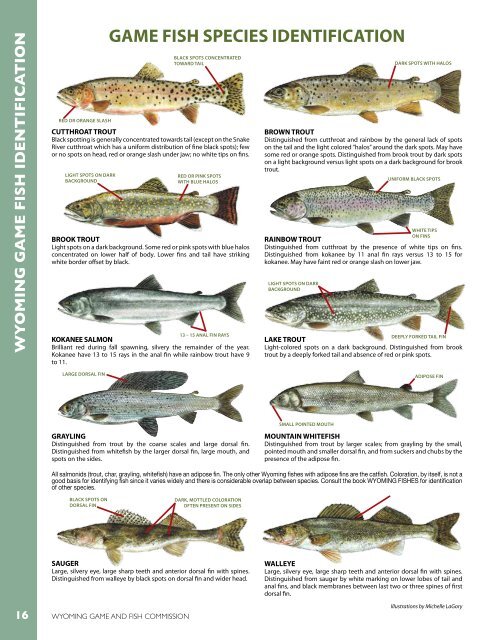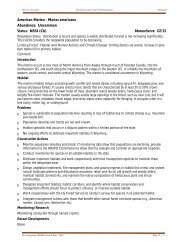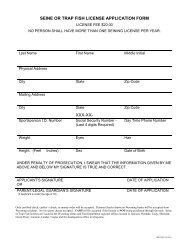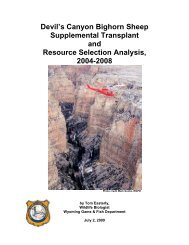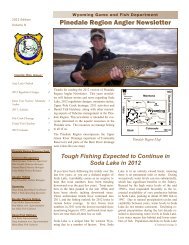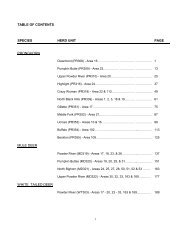wyoming fishing regulations - Wyoming Game & Fish Department
wyoming fishing regulations - Wyoming Game & Fish Department
wyoming fishing regulations - Wyoming Game & Fish Department
Create successful ePaper yourself
Turn your PDF publications into a flip-book with our unique Google optimized e-Paper software.
WYOMING GAME FISH IDENTIFICATION<br />
Red or orange SLASH<br />
light spots on dark<br />
background<br />
GAME FISH SPECIES IDENTIFICATION<br />
BLACK SPOTS CONCENTRATED<br />
TOWARD TAIL<br />
CUTTHROAT TROUT<br />
Black spotting is generally concentrated towards tail (except on the Snake<br />
River cutthroat which has a uniform distribution of fine black spots); few<br />
or no spots on head, red or orange slash under jaw; no white tips on fins.<br />
red or pink spots<br />
with blue halos<br />
BROOK TROUT<br />
Light spots on a dark background. Some red or pink spots with blue halos<br />
concentrated on lower half of body. Lower fins and tail have striking<br />
white border offset by black.<br />
13 – 15 ANAL FIN RAYS<br />
KOKANEE SALMON<br />
Brilliant red during fall spawning, silvery the remainder of the year.<br />
Kokanee have 13 to 15 rays in the anal fin while rainbow trout have 9<br />
to 11.<br />
DARK SPOTS WITH HALOS<br />
BROWN TROUT<br />
Distinguished from cutthroat and rainbow by the general lack of spots<br />
on the tail and the light colored “halos” around the dark spots. May have<br />
some red or orange spots. Distinguished from brook trout by dark spots<br />
on a light background versus light spots on a dark background for brook<br />
trout.<br />
WHITE TIPS<br />
ON FINS<br />
RAINBOW TROUT<br />
Distinguished from cutthroat by the presence of white tips on fins.<br />
Distinguished from kokanee by 11 anal fin rays versus 13 to 15 for<br />
kokanee. May have faint red or orange slash on lower jaw.<br />
LIGHT SPOTS ON DARK<br />
BACKGROUND<br />
UNIFORM BLACK SPOTS<br />
DEEPLY FORKED TAIL FIN<br />
LAKE TROUT<br />
Light-colored spots on a dark background. Distinguished from brook<br />
trout by a deeply forked tail and absence of red or pink spots.<br />
LARGE DORSAL FIN<br />
ADIPOSE FIN<br />
GRAYLING<br />
Distinguished from trout by the coarse scales and large dorsal fin.<br />
Distinguished from whitefish by the larger dorsal fin, large mouth, and<br />
spots on the sides.<br />
SMALL POINTED MOUTH<br />
MOUNTAIN WHITEFISH<br />
Distinguished from trout by larger scales; from grayling by the small,<br />
pointed mouth and smaller dorsal fin, and from suckers and chubs by the<br />
presence of the adipose fin.<br />
All salmonids (trout, char, grayling, whitefish) have an adipose fin. The only other <strong>Wyoming</strong> fishes with adipose fins are the catfish. Coloration, by itself, is not a<br />
good basis for identifying fish since it varies widely and there is considerable overlap between species. Consult the book WYOMING FISHES for identification<br />
of other species.<br />
BLACK SPOTS ON<br />
DORSAL FIN<br />
DARK, MOTTLED COLORATION<br />
OFTEN PRESENT ON SIDES<br />
SAUGER<br />
Large, silvery eye, large sharp teeth and anterior dorsal fin with spines.<br />
Distinguished from walleye by black spots on dorsal fin and wider head.<br />
16 WYOMING GAME AND FISH COMMISSION<br />
WALLEYE<br />
Large, silvery eye, large sharp teeth and anterior dorsal fin with spines.<br />
Distinguished from sauger by white marking on lower lobes of tail and<br />
anal fins, and black membranes between last two or three spines of first<br />
dorsal fin.<br />
Illustrations by Michelle LaGory


